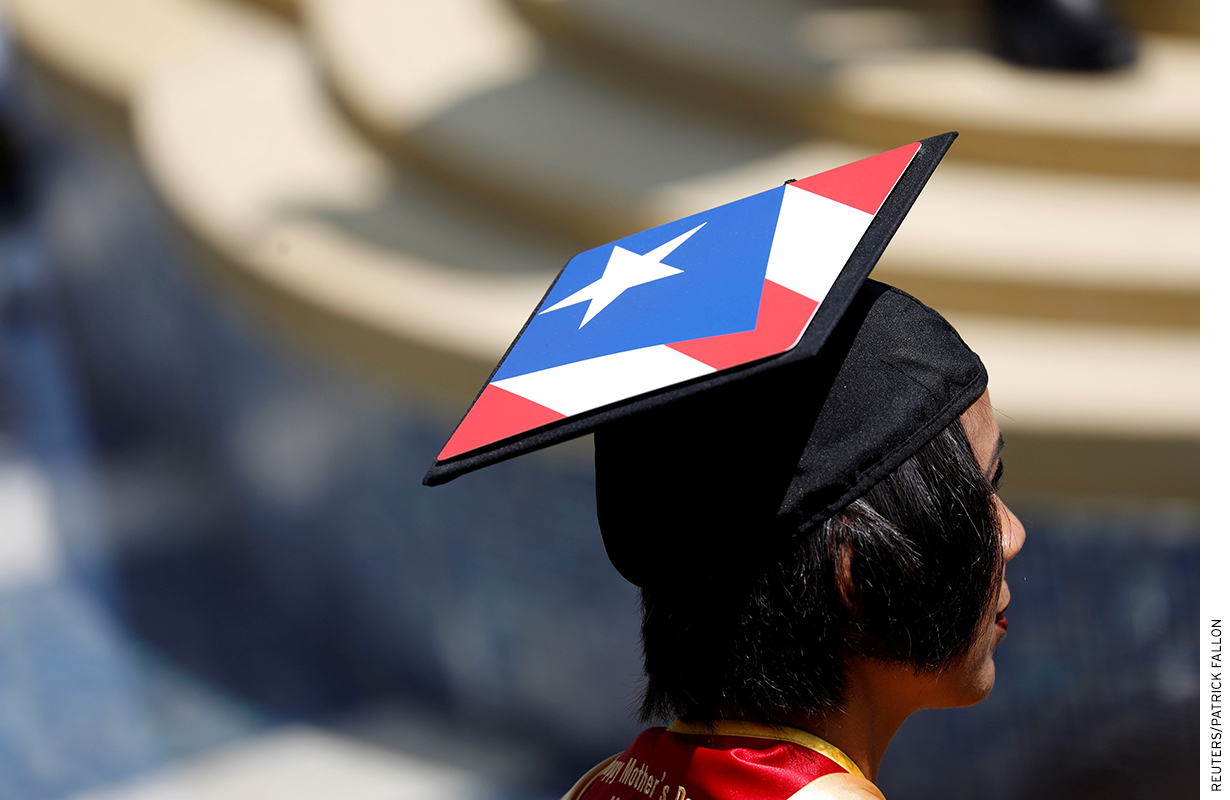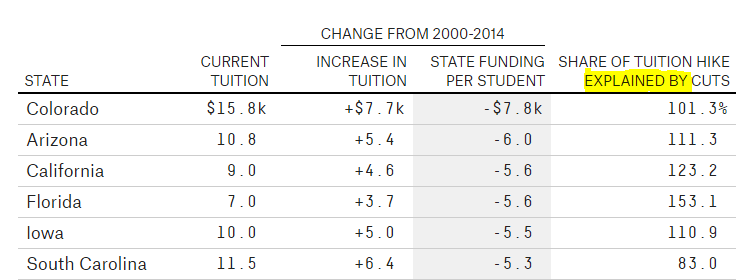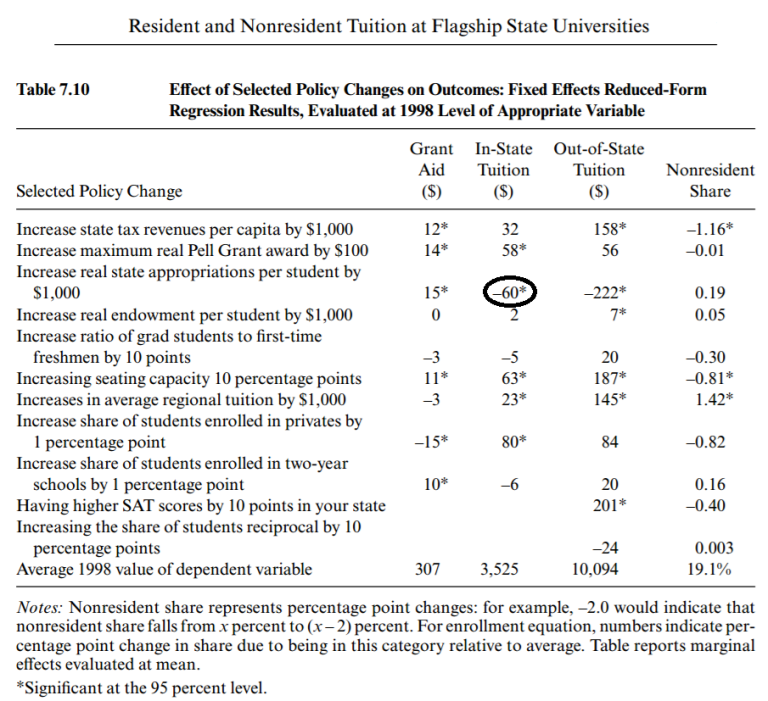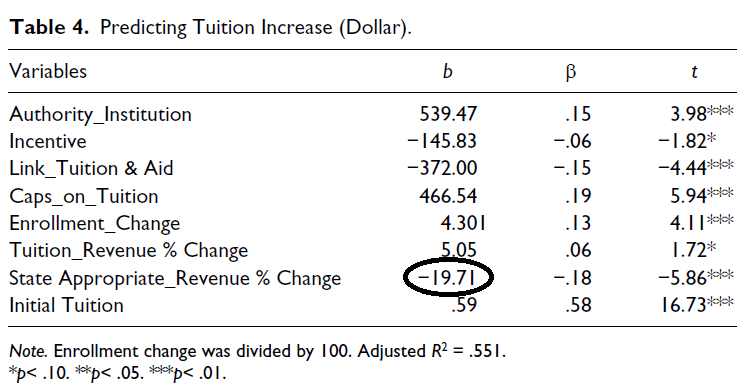
There are many popular explanations for why college tuition tends to rise faster than inflation, and each of these motivate different policy proposals about whether, how, and whom to subsidize in our higher education system. In recent years, two explanations, the so-called “Bennett Hypothesis” and “state disinvestment” (state funding cuts for public universities), have received a lot of attention. Surprisingly, researchers and the media have demanded very different levels of evidence to determine whether each explanation is a major driver of tuition. What would they find if they held both explanations to the same standards of analysis?
The Bennett Hypothesis
Researchers have been trying to prove or disprove the Bennett Hypothesis for three decades. President Reagan’s Secretary of Education William Bennett famously claimed in a 1987 New York Times op-ed that when the government issues more student loans and grants, it enables colleges and universities to raise tuition, negating the purpose of those government benefits. Bennett did not, however, cite any research to demonstrate that causal relationship. Rather, he treated the existence of two simultaneous trends—rising aid and rising tuition—as sufficient evidence of causality.
Researchers, journalists, and policymakers generally do not accept a simple comparison between trends in student aid and tuition as proof of the Bennett Hypothesis, and for good reason. Many other factors could explain why colleges and universities raise tuition. Isolating those factors is no easy feat, so researchers have been looking for evidence of the Bennett Hypothesis with ever more data and analytical firepower. One study published by the Federal Reserve Bank of New York in 2015 (revised in 2017) demonstrates the lengths to which researchers go in this effort. [1]
The authors used three different datasets to conduct the study. They first determined which colleges and universities had high and low shares of students borrowing at the maximum amounts allowed under the federal student loan program. They then examined how schools in each group adjusted tuition following a rare increase in the maximum amount students can borrow in the loan programs in 2007 and 2008. The study relies on a differences-in-differences statistical technique to isolate the effect that the change in borrowing limits had on tuition. If higher loan limits drive up tuition, schools with high shares of students already borrowing at the maximum should have seen larger tuition increases. The authors concluded colleges increased tuition between 15 and 60 cents for every $1 increase in borrowing limits.
Despite their rigor, studies like these are still contested. After all, the stakes are high. If government programs to help people pay for college actually push prices up, not down, then billions of dollars are being wasted.
Writing at length about the New York Fed paper, Libby Nelson of Vox aptly described the academic research on the Bennett Hypothesis as finding relationships that are “either complex or downright contradictory.” She goes on to caution reading too much into Bennett Hypothesis studies because “researchers, including those behind this new study, have generally found only evidence of correlation, not causation.” [2] In short, studies seeking to demonstrate a causal relationship between student aid and tuition must overcome significant skepticism.
State disinvestment and tuition at public universities
The sophisticated analytical techniques and the intensity of the debate over the Bennett Hypothesis stand in contrast to how researchers and the policy community treat another possible driver of tuition increases—state disinvestment. State disinvestment describes how state legislatures have reduced per-student appropriations to public colleges over time, especially during economic recessions. Because those appropriations are meant largely to offset costs at those institutions and thereby reduce tuition for in-state students, a reduction in the appropriation is said to cause colleges to increase tuition.
Both the state disinvestment argument and the Bennett Hypothesis are fundamentally about the effect of government subsidies on college tuition. But unlike the Bennett Hypothesis, the effect of state appropriations on tuition at public colleges is not debated, and evidence of a causal relationship is routinely asserted with a simple graph showing tuition rising and per-student appropriations falling.
For example, a 2012 New York Times piece by opinion columnist Catherine Rampell titled “Why Tuition Has Skyrocketed at State Schools” claims that the “main cause of tuition growth has been huge state funding cuts.” Her evidence? The chart reprinted below (Figure 1). [3] Numerous advocacy organizations and think tanks use this same information to show that declining per-student appropriations are the “primary driver” of tuition increases. [4] Unlike the Bennett Hypothesis, claims that changes in state appropriations are the biggest factor causing tuition increase are never challenged despite being based on nothing more than a comparison of two trends.
Figure 1. State college revenue per student

Note: Figures are per full-time equivalent student, in constant 2010 dollars adjusted by SHEEO Higher Education Cost Adjustment (HECA).
Sources: State Higher Education Executive Officers
Even academic researchers, who marshal complicated statistical models to test the Bennett Hypothesis, use simplistic analyses when it comes to state disinvestment. In a recent article for FiveThirtyEight, Doug Webber, a professor at Temple University, uses the same approach as Rampell and many others: he puts changes in tuition at public universities side-by-side with changes in state appropriations in a table, divides one column into the other, and then labels the result, “share of tuition hike explained by cuts” [Emphasis added]. [5] See Figure 2.
This type of analysis does not explain how much of the funding cut caused the increase in tuition any more than the same approach would explain the effect of student aid increases under the Bennett Hypothesis. Rather, it assumes that a causal relationship already exists, that it is dollar-for-dollar, and that no other factor could explain the changes in tuition. But a big clue that the relationship between state appropriations and tuition levels cannot be dollar-for-dollar is evident in Webber’s analysis. He finds that in many states, reductions in appropriations explain more than 100 percent of increases in tuition. Obviously, then, something in addition to cuts to appropriations must also explain why tuition rises.
Figure 2. Changes in funding and tuition at public universities
Source: Webber, “Fancy Dorms Aren’t the Main Reason Tuition is Skyrocketing.”
To put a fine point on the two very different standards of evidence demanded for the Bennett Hypothesis and state disinvestment, recall the earlier piece by Libby Nelson of Vox. She cautioned readers that the evidence is mixed and contradictory on the Bennett Hypothesis and that most research fails to establish a causal relationship. When it comes to claims about state disinvestment, however, Nelson offers no such warning. In describing Hillary Clinton’s 2016 presidential campaign proposal that would have encouraged states to reverse the disinvestment, Nelson says it is “trying to address a short-term reason college costs have gone up: that students are paying a greater share of the cost and states are paying less.” [6] And it’s not just Nelson: the causal relationship between state appropriations and tuition is presented as established fact in article after article.
Research on state disinvestment and tuition
There is another reason to question the effect of state disinvestment on tuition. A review of the academic literature turns up a surprisingly thin research base on the issue. Just three studies over the past two decades examined the relationship between appropriations and tuition using the same methodological standards applied to test the Bennett Hypothesis, and two of the three did so only tangentially. [7] The studies do, however, hint at what rigorous research methods reveal about the relationship between changes in appropriations and tuition during periods of both rising and falling appropriations.
National Center for Education Statistics
In 2001, the U.S. Department of Education’s National Center for Education Statistics published a study mandated by Congress that analyzed trends and relationships among costs, tuition prices, and revenues at colleges and universities from 1988 to 1997. [8] The study looked at correlations between changes in tuition and a number of variables, including state appropriations—although the authors used “sticker price” to measure tuition, not actual tuition revenues, which might affect the results. While careful not to suggest a causal relationship, the authors find that changes in appropriations account for between 19 percent and 28 percent of changes in published in-state tuition prices. Those figures are much lower than popular narratives might suggest. Even so, they are the high-water mark compared with what the other, more robust studies find.
Rizzo and Ehrenberg
Another study offering clues about state disinvestment was published in a 2004 National Bureau of Economic Research volume edited by Caroline M. Hoxby. [9] This study went beyond measuring correlates, aiming to infer causal relationships. The authors, Michael Rizzo and Ronald G. Ehrenberg, wanted to know why flagship and other large public universities enrolled different amounts of out-of-state students and what consequences those decisions had. As part of their effort, they examined a dozen factors that might be associated with changes in in-state and out-of-state tuition, including changes in appropriations from state governments. Their study looks at these changes for 98 universities between 1979 and 1998.
Buried in this 50-page paper is a major finding with respect to state disinvestment: the magnitude of the effect of a reduction in state appropriations on tuition is miniscule. The authors find that, “for the average institution in our sample, it would take an increase of $1,000 in state appropriations per student to generate an in-state tuition reduction of only $60.” That means six cents of every dollar in appropriations find their way into lower tuition. The effect on out-of-state tuition would be slightly larger, the study shows, with the same $1,000 increase in appropriations driving tuition down by $222. See Figure 3. Rizzo and Ehrenberg do not delve further into this finding, leaving readers to speculate why changes in appropriations have such a small effect on tuition.
Figure 3. Effect of selected policy changes on outcomes: Fixed effects reduced-form regression results, evaluated at 1998 level of appropriate variable
Source: Rizzo and Ehrenberg, “Resident and Nonresident Tuition and Enrollment at Flagship State Universities.”
A skeptic might argue that the data in this 2004 study are too outdated to have any bearing on recent state disinvestment. Luckily, the second study on this topic picks up where Rizzo and Ehrenberg left off. And for those concerned that the Rizzo and Ehrenberg study looks only at large, public universities, the second study is more comprehensive.
Kim and Ko
In 2014, Mikyong Minsun Kim of The George Washington University and Jongwan Ko of Sungkyunkwan University in Seoul, South Korea, published a study that examined the effects of state policies on tuition at public universities between 1998 and 2007. [10] Like Rizzo and Ehrenberg, they were not directly interested in the effect of appropriations on tuition, but included it in their study as a control variable. They also describe their findings in terms of causal relationships. But unlike the Rizzo and Ehrenberg study, which uses data for individual universities, Kim and Ko use state-level data for all public universities in each state.
Despite the different time period and focus on state-level data, Kim and Ko also find that changes in appropriations have a very small effect on tuition at public universities. They present this finding in a different way than Rizzo and Ehrenberg and it requires some interpretation to make it comparable.
In 2015, the median revenue per student that public colleges and universities collected was $19,053, which includes all sources of revenue (e.g., tuition, research funding, state appropriations, etc.). According to Kim and Ko, if state appropriations were to increase as a share of that total revenue by one percentage point, which would be an increase of $191 per student, tuition at public colleges and universities would be expected to fall by $19.71. (See Figure 4.) That means just ten cents of every dollar increase in appropriations would find their way into lower tuition, an effect similar in magnitude to what Rizzo and Ehrenberg found for an earlier time period.
Figure 4. Predicting tuition increase (dollar)
Source: Kim and Ko, “The Impacts of State Control Policies on College Tuition Increase.”
Like Rizzo and Ehrenberg, Kim and Ko do not discuss the implications of this finding, nor do they provide any thoughts on why appropriations appear to have such little influence on tuition. In fact, the authors of these studies seem to view their findings as confirmation of what everyone assumes is the case: that there is a negative relationship between appropriations and tuition. Such a perspective may have led them to conclude that their findings were not that interesting.
But the magnitude of the relationship they find matters, too, especially in the context of the current policy debates. If the relationship between state appropriations and tuition at public universities is as weak as the two studies show, the ubiquitous claim that cuts to state funding are the “primary driver” of changes in tuition are simply not supported by the research.
Policy and research implications
In recent years, countless advocacy organizations and interest groups have urged policymakers to increase appropriations to public colleges based on the view that those dollars would flow to students through lower tuition. Some of these proposals would provide billions in new federal funds to induce states to increase appropriations to public colleges and universities. [11] The 2016 presidential campaign was also full of language about state governments needing to spend more on public universities to reduce tuition. [12]
But the available research suggests that if state lawmakers increased appropriations for public colleges and universities, it would be unlikely to have an effect as large as advocates assume. More state funding appears to buy pennies on the dollar in lower tuition. That makes increasing appropriations for public colleges and universities an ineffective—even wasteful—policy for keeping tuition low. It also implies that grant aid might deliver more bang for the buck than larger state appropriations.
What might explain why appropriations have such weak effect on tuition? Again, the studies discussed above do not offer much explanation, but two theories come to mind: perhaps universities look to exploit their pricing power in the market leading them to raise tuition whether appropriations rise or fall; or maybe when faced with a reduction in state funding, universities cut spending instead of raising tuition dollar for dollar. Those are excellent theories for future research to test.
To be sure, the research on the effects of state disinvestment is severely limited, and further work may yet find a stronger effect on tuition. But limitations are not a reason to continue assuming the effects are as large as many have claimed. Just the opposite.
The fact that the research is limited, and that it shows state disinvestment is not a major cause of rising tuition, are reasons to doubt the state disinvestment argument and the policy agenda attached to it. Researchers should see this as a call to action. They should be putting at least as much effort into measuring the effects of state appropriations on tuition as they do the Bennett Hypothesis—and employing the same rigorous analytical methods. They can also help determine what factors really are the primary drivers of tuition increases at public colleges if appropriations matter so little. Journalists should also change their approach in light of the evidence on state disinvestment. They should hold claims about the effects of state disinvestment on tuition to the same standards of evidence as they do claims about the Bennett Hypothesis.
Meanwhile, it is time to start calling the claim that state funding cuts are the primary driver of rising tuition what it really is: the state disinvestment hypothesis.
— Jason Delisle
 Jason Delisle is a resident fellow at the American Enterprise Institute (AEI), where he works on higher education financing with an emphasis on student loan programs.
Jason Delisle is a resident fellow at the American Enterprise Institute (AEI), where he works on higher education financing with an emphasis on student loan programs.
This post originally appeared as part of Evidence Speaks, a weekly series of reports and notes by a standing panel of researchers under the editorship of Russ Whitehurst.
The author(s) were not paid by any entity outside of Brookings to write this particular article and did not receive financial support from or serve in a leadership position with any entity whose political or financial interests could be affected by this article.
Notes:
1. David O. Lucca, Taylor Nadauld, and Karen Shen, “Credit Supply and the Rise in College Tuition: Evidence from the Expansion in Federal Student Aid Programs,” (staff report no. 733, Federal Reserve Bank of New York, New York, NY, February 2017), www.newyorkfed.org/medialibrary/media/research/staff_reports/sr733.pdf.
2. Libby Nelson, “Our Greedy Colleges: Why Financial Aid Might Make College More Expensive,” Vox, August 12, 2015, www.vox.com/policy-and-politics/2015/8/12/9130157/financial-aid-tuition-bennett-hypothesis.
3. Catherine Rampell, “Why Tuition Has Skyrocketed at State Schools,” New York Times Economix Blog, March 2, 2012, https://economix.blogs.nytimes.com/2012/03/02/why-tuition-has-skyrocketed-at-state-schools/?_r=0.
4. Robert Hiltonsmith, Pulling Up the Higher-Ed Ladder: Myth and Reality in the Crisis of College Affordability, Demos, 2015, www.demos.org/sites/default/files/publications/Robbie%20admin-bloat.pdf; David A. Bergeron, Elizabeth Baylor, and Antoinette Flores, “A Great Recession, a Great Retreat,” Center for American Progress, October 27, 2014, www.americanprogress.org/issues/education/reports/2014/10/27/99731/a-great-recession-a-great-retreat/.
5. Doug Webber, “Fancy Dorms Aren’t The Main Reason Tuition Is Skyrocketing,” FiveThirtyEight, September 13, 2016, https://fivethirtyeight.com/features/fancy-dorms-arent-the-main-reason-tuition-is-skyrocketing/.
6. Libby Nelson, “Hillary Clinton’s College Affordability Plan, Explained,” Vox, August 10, 2015, www.vox.com/2015/8/10/9125349/hillary-clinton-college.
7. This discussion excludes the limited number of studies that did not examine changes in appropriations and tuition but instead looked at a one-year snapshot of those data. These studies examined what variables were associated with high or low levels of tuition at public universities and included appropriations in the analysis. For example, a 2000 chapter by Rajindar Koshal and Manjulika Koshal is widely cited in the literature on the relationship between appropriations and tuition. But that paper was only able to show that in states with larger appropriations tuition was generally lower, controlling for other factors. It is not an analysis of how changes in appropriations relate to changes in tuition. They found that tuition depends on state appropriation, median family income, out-of-state enrollment, and geographic region. See Rajindar K. Koshal and Manjulika Koshal, “State Appropriation and Higher Education Tuition: What Is the Relationship?,” Education Economics 8, no. 1 (April 2000): 81-89.
8. National Center for Education Statistics, Study of College Costs and Prices, 1988–89 to 1997–98, Volume I, December 2001, https://nces.ed.gov/pubs2002/2002157.pdf.
9. Michael Rizzo and Ronald G. Ehrenberg, “Resident and Nonresident Tuition and Enrollment at Flagship State Universities,” in ed., Caroline M. Hoxby, College Choices: The Economics of Where to Go, When to Go, and How to Pay For It (Chicago, IL: University of Chicago Press, September 2004): 303-353, www.nber.org/chapters/c10103.pdf.
10. Mikyong Minsun Kim and Jangwan Ko, “The Impacts of State Control Policies on College Tuition Increase,” Educational Policy 29, no. 5 (July 2015): 815-838, http://journals.sagepub.com/doi/abs/10.1177/0895904813518100.
11. Daniel J. Hurley, Thomas L. Harnisch, Barmak Nassirian, A Proposed Federal Matching Program to Stop the Privatization of Public Higher Education, American Association of State Colleges and Universities, January 2014, www.aascu.org/policy/publications/policy-matters/federalmatchingprogram.pdf; The Education Trust, Doing Away With Debt: Using Existing Resources to Ensure College Affordability for Low and Middle-Income Families, 2013, http://edtrust.org/wp-content/uploads/2013/10/Doing_Away_With_Debt.pdf.
12. See Hillary for America, “Hillary Clinton’s New College Compact,” August 10, 2015, www.hillaryclinton.com/briefing/factsheets/2015/08/10/college-compact/; and Michael Stratford, “Clinton vs. Sanders on States’ Role,” Inside Higher Ed, April 6, 2016, www.insidehighered.com/news/2016/04/06/clinton-sanders-spar-over-state-participation-their-free-college-plans.





